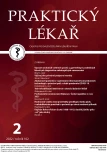Tele-rehabilitation intervention in home balance treatment
Authors:
M. Zádrapová 1,2; E. Mrázková 1,3; I. Fiedorová 1,2
Authors‘ workplace:
Ostravská univerzita Lékařská fakulta Ústav epidemiologie a ochrany veřejného zdraví, Přednosta: doc. MUDr. Rastislav Maďar, Ph. D., MBA, FRCPS
1; Fakultní nemocnice Ostrava Klinika rehabilitace a tělovýchovného lékařství, Přednosta: doc. MUDr. Dalibor Pastucha, Ph. D., MBA
2; Krajská nemocnice Havířov Oddělení ORL a chirurgie hlavy a krku, Primářka: MUDr. Eva Mrázková, Ph. D.
3
Published in:
Prakt. Lék. 2022; 102(2): 69-73
Category:
Of different specialties
Overview
Backround: Regularity and correctness of rehabilitation exercises in the home environment is one of the basic preconditions for successful treatment. During rehabilitation in the home environment, the rehabilitation effect is often reduced due to irregularity of therapy, poor execution of exercises or insufficient number of individual repetitions. The aim of this clinical study was to evaluate the effect of a tele-rehabilitation intervention on the frequency and success of home balance therapy in patients after knee injuries.
Methodology: The control group consisted of 8 subjects (4 females, 4 males, age ± 40 years). The study group consisted of 8 persons (5 women and 3 men, age ± 39 years). At baseline, both groups were examined by anamnestic and questionnaire examination and at entry and exit by examination on a stabilometric platform – ICS Balance platform. Both groups performed a 3-week balance therapy on a spherical cup allowing sensing and visualization of the movement on a computer monitor or smart device. For the research group, the therapy was supplemented with a tele-rehabilitation intervention.
Results: tele-rehabilitation intervention can be successfully used in home balance therapy. The results show that the Tele-rehabilitation intervention leads to a higher frequency of balance aid use and a greater difference in stability test scores between baseline and outcome measurements.
Keywords:
balance training – Physiotherapy – knee joint – tele-rehabilitation
Sources
1. Azhari A, Parsa A. Covid-19 outbreak highlights: importance of home-based rehabilitation in orthopedic surgery. Arch Bone Jt Surg 2020; 8(Suppl 1): 317–318.
2. Darware M, Naqvi WM. A case report on physiotherapy rehabilitation accelerating the recovery of older patient with anterior cruciate ligament reconstruction. Medical Science 2020; 24(103): 1803–1808.
3. Dungl P. Ortopedie. Praha: Grada Publishing 2014.
4. Fioratti I, Fernandes LG, Reis FJ, Saragiotto BT. Strategies for a safe and assertive telerehabilitation practice. Braz J Phys Ther 2021; 25(2): 113–116.
5. Jansen-Kosterink S, Dekker-van Weering M, van Velsen L. Patient acceptance of a telemedicine service for rehabilitation care: A focus group study. Int J Med Inform 2019; 125: 22–29.
6. Karakoç ZB, Çolak TK, Sari Z, Polat MG. The effect of virtual rehabilitation added to an accelerated rehabilitation program after anterior cruciate ligament reconstruction: a randomized controlled trial. Clin Exp Health Sci 2019; 9(2): 124–129.
7. Kolář P. Rehabilitace v klinické praxi. Praha: Galén 2009.
8. Molka AZ, Lisinski P, Huber J. Visual biofeedback exercises for improving body balance control after anterior cruciate ligament reconstruction. J Phys Ther Sci 2015; 27(7): 2357–2360.
9. Naeemabadi M, Søndergaard JH, Klastrup A, et al. Development of an individualized asynchronous sensor-based telerehabilitation program for patients undergoing total knee replacement: Participatory design. Health Informatics J 2020; 26(4): 2492–2511.
10. Pereira A, Folgado D, Nunes F, et al. Using inertial sensors to evaluate exercise correctness in electromyography-based home rehabilitation systems. Symposium on Medical Measurements and Applications (Memea), 2019 [online]. Dostupné z: https://www.researchgate. net/publication/335197089_Using_Inertial_Sensors_ to_Evaluate_Exercise_Correctness_in_Electromyography-based_ Home_Rehabilitation_Systems [cit. 2022-02-16].
11. Tsvyakh AI, Hospodarskyy AY, Marchenkova NO, et al. Telerehabilitation of the knee joints of patients with polytrauma. Wiad Lek 2021; 74(1): 48–51.
12. van Melick N, van Cingel RE, Brooijmans F, et al. Evidencebased clinical practice update: practice guidelines for anterior cruciate ligament rehabilitation based on a systematic review and multidisciplinary consensus. Br J Sports Med 2016; 50(24): 1506–1515.
13. Vourganas I, Stankovic V, Stankovic L, Michala AL. Evaluation of home-based rehabilitation sensing systems with respect to standardised clinical tests. Sensors 2020; 20(1): 26.
14. Wüest S, Borghese NA, Pirovano M, et al. Usability and effects of an exergame-based balance training program. Games Health J 2014; 3(2): 106–114.
Labels
General practitioner for children and adolescents General practitioner for adultsArticle was published in
General Practitioner

2022 Issue 2
- Memantine Eases Daily Life for Patients and Caregivers
- Metamizole vs. Tramadol in Postoperative Analgesia
- Metamizole at a Glance and in Practice – Effective Non-Opioid Analgesic for All Ages
- Memantine in Dementia Therapy – Current Findings and Possible Future Applications
- What Effect Can Be Expected from Limosilactobacillus reuteri in Mucositis and Peri-Implantitis?
Most read in this issue
- Nutrition as primary support of immunity
- The importance of personal internal feelings ("gut feeling") of general practitioners in the diagnosis of oncological diseases
- Patient experience with the use of information and communication technologies in primary care during the COVID-19 pandemic
- Nezapomínáte na prevenci? Přeočkování proti tetanu je stále důležité
